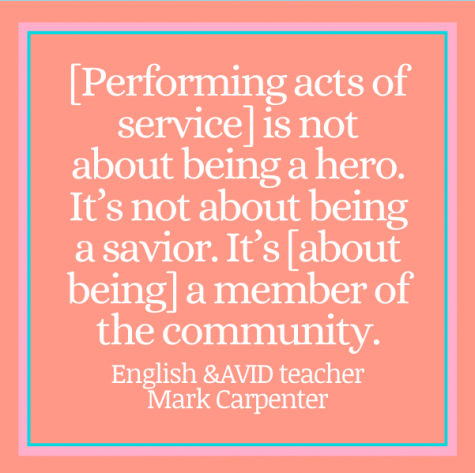Performing Acts of Service
Students and teachers explore how acts of service affect their lives.

Graphic by Mikaylah Du
October 29, 2021
English and AVID teacher Mark Carpenter has a simple, but apt definition of “acts of service.”
“An act of service is helping someone, period.” Carpenter said.
The simplicity of Carpenter’s straightforward definition is reminiscent of how acts of service may seem insignificant — an idea bolstered by junior Julianna Kimm, who claims that an act of service “might seem small to you, but might be big to [someone else].”
As part of Leadership’s Matador Recognition Commission — a group that aims to acknowledge and appreciate staff and students at MV — Kimm performs acts of service almost daily. Specifically, her commission gives coffee to staff, raises money for various organizations, provides menstrual products to students and more.
Acts of service are also an integral part of junior Emi Kosakura’s daily routine, as she goes out of her way to ask how her friends and classmates are doing or brings food for her friends.
Kosakura recalls how acts of service from others have impacted her own life, from having her friends deliver boba to simply being there for her when times were hard. Similarly, Kimm also remembers the time her friends sent her McDonald fries through DoorDash simply because she expressed a craving for them on a group chat.
Both juniors say these seemingly trivial actions made their day. Carpenter affirms that these small actions make a big difference, saying that the kindness of their students are a reminder of how wonderful the community can be even on the bleakest of days.
“We tend to talk about people as selfish [and] focus on negative qualities, but I see so many small acts of service every day that people do without thinking about it,” Carpenter said. “It is natural, it is normal and it is kind of almost automatic.”
Nevertheless, Carpenter cautions that acts of service should always be carried out under reasonable parameters, with consideration for what one gains in return.
“[There is a difference between] seeing acts of service as acts of solidarity versus acts of selflessness,” Carpenter said. “The idea of solidarity is contributing to something that I’m a part of, something that is mutually beneficial, versus selflessness, which is just giving, giving, giving, without getting anything back.”
Similarly, Koskaura mentions that these acts don’t always accomplish what they set out to do. In fact, although acts of service may be done with a positive intention, Carpenter points that there’s a thin line between helping and meddling, and there have been times in their life when their relationships suffered because they overstepped in their attempts to help others.
Kimm explains that she has experienced a different kind of setback while performing acts of service. She recalls that when MatRec prepared to celebrate faculty birthdays, the process of waking up early to decorate the classroom with balloons and prepare a goody bag of small gifts – when she often spent the night before studying for a test late into the night – was overwhelming at times, a load only exacerbated by a lack of sleep and the consecutive celebrations. However, Kimm maintains that it was worth it because seeing its positive impact on others made her happy.

“You don’t know how much you can impact someone’s life, even if it’s a small thing,” Kimm said. “Just you doing something kind [for] them might make their day a little easier, a little better.”
Kosakura says that recognizing these actions forms a stronger relationship between people. Likewise, Carpenter concurs that performing acts of service creates a cycle that’s advantageous for everyone, building a stronger community.
“[Performing acts of service] is not about being a hero,” Carpenter said. “It’s not about being a savior. It’s not about being looked up to. It’s [about being] a member of the community.”

















